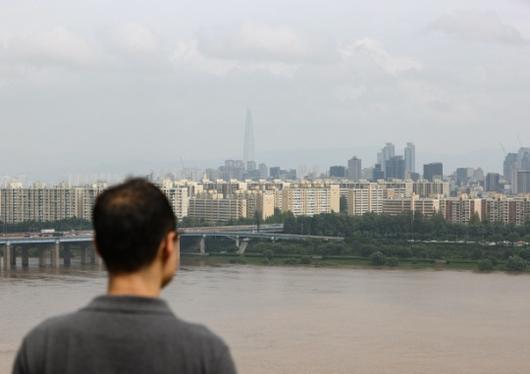 |
It Already Feels Suffocating…: One citizen gazes at the Hyundai Apartment complex in Apgujeong-dong from near the UN Village in Yongsan-gu, Seoul on the afternoon of August 4. Yonhap News |
The government announced that it would supply more than 132,000 new homes in Seoul by 2028 with public reconstruction and redevelopment projects, by securing new housing sites, such as the Taeneung Golf Club, and by increasing the floor space index (FSI) in the phase-3 new towns. The government decided to ease the FSI regulation in Seoul as well as the 35-floor height restriction to allow high-density development in the city center. The latest measures were intended to send a clear message of “more housing supply” to an overheated market, but they also triggered concerns of side effects, such as the problem of overcrowded development and environmental damage due to the removal of the green belt (development restricted area).
According to “Measures to Increase Housing Supply in the Seoul Metropolitan Area” released by the government on August 4, of the 132,000 new homes that will be supplied, 107,000 will be located in Seoul and the remaining 25,000 will be supplied in existing phase-3 new cities (20,000) and idle land near Seoul. The number of houses in Seoul may increase when changes are made to the land use in the future.
The government plans to secure 70,000 (62.5%) homes in Seoul by strengthening the public nature of urban renovation projects, such as public high-density reconstruction projects (50,000 homes) and public redevelopment projects (20,000). Public high-density reconstruction refers to projects, in which public entities like the Korea Land and Housing Corporation (LH) are involved. The government will ease the regulation on the floor space index to up to 500% in the type-3 general residential area, and instead secure half of the increased number of housing through public sales and leases. In this case, the government will upgrade the use district to a quasi-residential area and allow developers to build buildings up to 50 stories high.
The government will develop new housing sites in the city of Seoul to provide 28,000 homes. They will build 10,000 housing units in the Taeneung Golf Club, which lies in the green belt, and construct 3,100 units in Camp Kim in Yongsan--the government is scheduled to reclaim the site--and 3,500 units on the site of the Western Driver’s License Test Center in Mapo. The state will provide a total of 9,400 houses in seventeen spots of idle land in Seoul owned by public organizations, such as the unsold land in the Sangam DMC (2,000 units) and Myeonmok Administration Complex Town (1,000).
The government will build 4,200 more units on the site of the Seoul Medical Center and the Yongsan maintenance depot, previously designated as housing development sites. The government will renovate old public rental housing in downtown Seoul and modify the use of empty studio apartments referred to as “officetels” to residential housing to secure 5,000 units. It will also seek out homes newly registered as housing due to future lifting of city regulations.
Hong Nam-ki, deputy prime minister cum minister of economy and finance said, “We reviewed all means available from square one to secure the supply of as many housing units as possible,” and added, “We will provide more than half of the increased supply to people buying their first homes, young people, and newly weds and provide end users with stable housing.”
However, there was criticism of the government’s policy to expand supply. Choi Eun-young, director of the Korean Center for City and Environment Research said, “Real estate prices soared because the government failed to properly restrain demand, such as the side effects of registered leasing businesses. And the government released the wrong answer to the problem by increasing supply.” She argued, “If the government supplies 100,000 more housing units with the city already saturated, it can aggravate problems of traffic congestion and overdevelopment.” Kim Dong-eon, head of the ecological city team at the Seoul Federation for Environmental Movements said, “If they develop the Taeneung Golf Club, which had been restricted as part of the green belt since the 1960s, into a residential area, an urban green area will be seriously destroyed,” and added, “I wonder if the government conducted a proper environmental assessment of the site in question.”
▶ 장도리 | 그림마당 보기
▶ 경향 유튜브 구독▶ 경향 페이스북 구독
©경향신문(www.khan.co.kr), 무단전재 및 재배포 금지
이 기사의 카테고리는 언론사의 분류를 따릅니다.
기사가 속한 카테고리는 언론사가 분류합니다.
언론사는 한 기사를 두 개 이상의 카테고리로 분류할 수 있습니다.
언론사는 한 기사를 두 개 이상의 카테고리로 분류할 수 있습니다.


